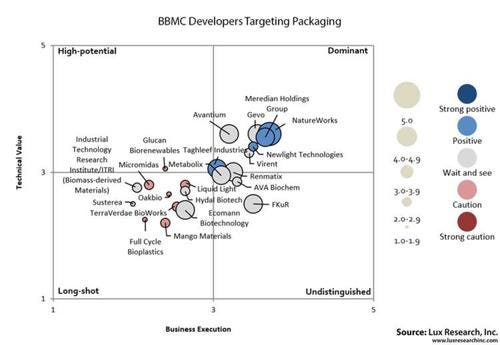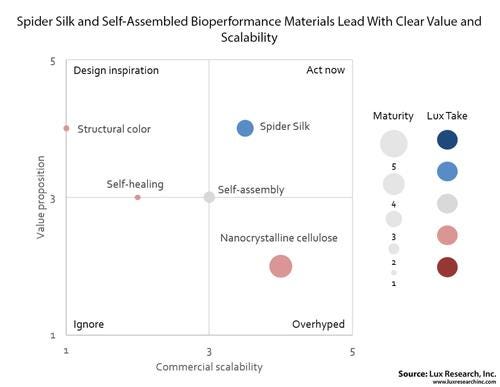October 19, 2016

Although it may sound counter-intuitive, some next-generation bio-based materials are superior in performance to their counterparts derived from petroleum. This is especially true of certain biopolymers, adhesives, coatings, and advanced materials. However, they also face some commercial challenges.
In various applications from transportation and industrial to energy and packaging, bio-based materials have demonstrated performance benefits over petroleum-derived incumbents, Ross Kozarsky, Lux Research Senior Analyst, told Design News. He is co-author of a recent report, Hunting for Value and Performance in the Bio-based Materials and Chemicals Space.
"The bio-based space and the entire industry has had a bad reputation," he said. "Many first-generation products like starch-based plastics were clearly inferior. Second-generation bio-based equivalent products were the exact same chemicals as petroleum-based products, but derived from bio-based materials. They were green and cost less. But once the price of oil went down, they lost much of their value proposition."

Now we're entering an era where performance is the major goal, and there are several pockets of value and success in the industry. But there's still a perception of poor quality for many bio-based materials. "In the past, there wasn't enough strategic thinking on the part of manufacturers about the entire value chain," Kozarsky said. "The approach was more like, wouldn't it be cool if we could make this green material? and not enough thought about cost and performance, which is what counts on the customer end."
Lux Research analysts set out to highlight specific downstream applications where promising areas of technology development in specialty chemicals, biopolymers, and advanced materials can offer concrete value propositions. They evaluated bio-based materials on the Lux Innovation Grid, focusing on six areas: advanced materials, adhesives, coatings, lubricants, personal care and cosmetics, and packaging.
READ MORE ARTICLES ON BIO-BASED MATERIALS:
In adhesives, the demand is for more sustainable adhesive technology, such as lignin-derived products, and several startups have promising technology. But this must be coupled with performance and many of these have improved properties, such as better curing time, ease of handling, and high resistance to UV and water, said Kozarsky. Environmental concerns continue to drive coatings, including the regulatory push for decreasing their volatile organic compound (VOC) content. Commercial progress in bio-based coatings is mixed, although some firms have promising technologies. Applications include the automotive, industrial, and packaging industries.
Packaging is a primary use case for biopolymers, primarily because of the huge volumes, said Kozarsky. It accounts for almost 40% of global plastic consumption. Polylactic acid (PLA) and polyhydroxylalk anoate (PHA) biopolymers have better material properties, such as tensile strength and tensile modulus, than their petroleum-derived counterparts, including high-density polyethylene (HDPE), low-density polyethylene (LDPE), and polypropylene (PP). But cost remains an issue. Although replacing the widely used and economical polyethylene terephthalate (PET) won't be easy, there are several manufacturers of potentially disruptive bio-based materials aiming at that goal, said Kozarsky. Other applications for biopolymers include barrier-type uses.

The study also looked at some very advanced bio-based materials that will take much longer before they reach commercialization. These include spider silk and nanocrystalline cellulose (NCC). Although both have disruptive potential, they face non-trivial commercial challenges. "We think NCC has been overhyped," said Kozarsky. "It's suffered from trying to be too many things to too many applications, and none of the applications have been proven commercially, even though capacities are being expanded."
Spider silk, along with self-assembled, self-healing, and structural color biomaterials, is included in another new Lux Research report, Navigating the Web of Bio-based Performance Materials. Spider silk is scalable and has solid, concrete application development in textiles, fibers, and athletic gear. Materials that self-assemble are also highly scalable.
With more advanced materials such as these, whether or not they are bio-based may be less important than what they can do. "If you look at these three bioperformance material areas -- self-assembled, self-healing, and structural color -- these materials are less scalable in a bio-based sense," said Kozarsky. "But you could try creating materials with these properties based on 'regular' materials, using a biomimicry approach." In other words, they can serve as design paradigms to inspire how materials may be created to achieve their separate goals.
[images via Lux Research]
Ann R. Thryft is senior technical editor, materials & assembly, for Design News. She's been writing about manufacturing- and electronics-related technologies for 29 years, covering manufacturing materials & processes, alternative energy, and robotics. In the past, she's also written about machine vision and all kinds of communications.
About the Author(s)
You May Also Like



